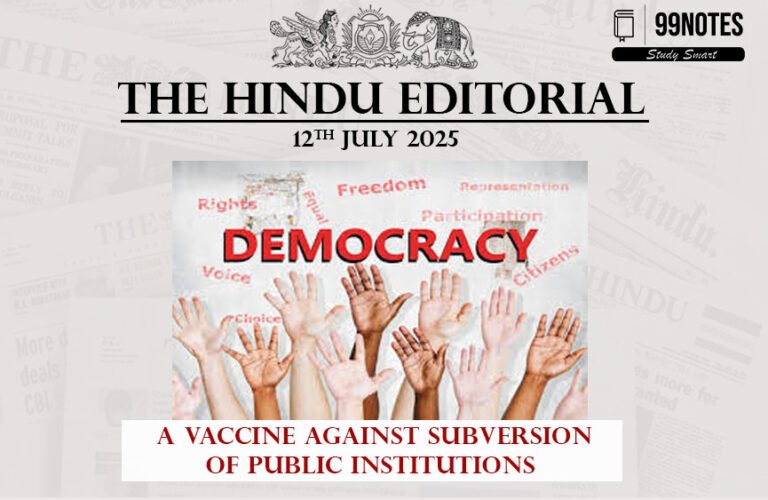29 February 2024 : The Hindu Editorial Notes PDF
The Hindu Editorial
29-February-2024
1. Vignettes of a Janus-faced economy
| Topic: GS3 – Indian Economy UPSC Significance: Analyzes dualism in the Indian economy, evaluating claims, welfare initiatives, and financial market concerns for holistic understanding. |
| Context |
|
Introduction:
- The Indian economy, marked by contradictions, presents challenges in assessing its performance.
- Government claims of growth coexist with indicators of distress, revealing a dual nature and raising concerns for sustainable development.
Contradictory Indian Economy:
- Mixed Performance: The Indian economy presents neither clear success nor collapse, posing challenges for government and opposition in evaluation.
Government’s Claims and Highlights:
- Size and Growth of GDP: Government emphasizes India’s projected third-largest GDP and high growth rates compared to emerging economies.
- Poverty Reduction: Claims highest recent poverty reduction due to inclusive policies, but skepticism arises about independent analysis of this claim.
- Stock Market Boom: Cites soaring stock market indices as evidence of entrepreneurship and wealth creation, contributing to a ‘premiumisation’ narrative.
High-Frequency Indicators and Dual Economy:
- Premiumisation Narrative: Indicators like passenger car sales, air traffic, demat accounts, and luxury sales create an image of an upwardly mobile population.
- Dual Economy Existence: Despite growth indicators, a dual economy is evident, necessitating major welfare initiatives.
Welfare Initiatives and Economic Dualism:
- Free Food Grain Distribution: Government extends free food grain distribution for five years, covering a significant portion of the population.
- MGNREGS Demand: Despite economic growth, demand for rural jobs under MGNREGS remains high, indicating latent unemployment and dualism.
Rural Incomes and Indebtedness:
- Real Wages Growth Decline: Rural real wages’ annual growth rate becomes negative, contributing to the perpetuation of dualism.
- Household Indebtedness: Rural households exhibit higher indebtedness, signalling economic challenges and slow growth of rural incomes.
Concerns about Financial Markets:
- Explosive Options Trading: Surge in demat accounts aligns with a significant increase in speculative options trading, raising concerns about investor losses.
- Speculative Trading Worries: Retail investors’ short-term focus and losses in options trading prompt concerns about long-term wealth building strategies.
Sustainable Development Goals (SDG) and Future Challenges:
- $5-Trillion Economy Projection: India aims to cross the $5-trillion mark by 2029, becoming the third-largest economy, but challenges in achieving SDG targets may impact claims of economic growth.
- SDG Targets by 2030: As the world approaches SDG deadlines, India’s progress will be critical in assessing the veracity of economic growth claims.
Conclusion:
- Janus-Face of the Economy: The contradictory nature of India’s economic performance necessitates a convergence towards addressing dualism and achieving sustainable development goals by 2030.
- The intricate analysis of India’s dualistic economy underscores the imperative for comprehensive policies addressing contradictory growth indicators, welfare gaps, and financial market challenges to achieve sustainable and inclusive development.
| Practice Question: Investigate the dualistic nature of the Indian economy, considering contradictory indicators, welfare initiatives, and financial market concerns. Discuss policy implications. (150 words/10 m) |
2. The economic case for investing in India’s children
| Topic: GS2 – Social Justice – Vulnerable sections, Education UPSC Relevance: Evaluates the historical neglect of early childhood education, emphasizing its critical role in holistic national development. |
| Context |
|
Introduction:
- Despite India’s demographic emphasis, early childhood education (ECE) has historically been marginalized.
- Shifting perceptions and government initiatives signal a newfound recognition of ECE’s pivotal role in national development.
Neglected Early Childhood Education (ECE):
- Underexplored Domain: ECE has historically been overlooked, possibly due to trivialization and association with traditional women’s roles.
Changing Perception and Government Initiatives:
- Shift in Focus: Government’s new survey on working women reflects changing perceptions, acknowledging care work and ECE as vital for national development.
- Historical Educational Focus: India has traditionally focused on primary education, achieving 100% gross enrolment ratio, but struggles with learning outcomes and foundational skills.
Increasing Focus on Early Childhood:
- Shift in Lifecycle Focus: Recent initiatives like NIPUN Bharat and Poshan Bhi Padhai Bhi indicate a shift towards addressing challenges in early childhood, particularly for children under six.
- Budgetary Allocations: The interim Budget 2024 promises expedited upgradation of Saksham Anganwadis and Ayushman Bharat services, reflecting a commitment to ECCE.
- Budget Overview: While teaching-learning material outlay tripled, the total budget for centrally sponsored schemes, including ECCE, remains lower than education and health missions.
Research and Evidence for Investment:
- Micro to Macro Connection: The need for research arises to align micro-level gains, such as cognitive and motor skill improvements, with macroeconomic implications, emphasizing the potential benefits of strong ECCE.
- Longitudinal Studies: India requires systematic and rigorous research, akin to international studies, to determine the opportunity cost of insufficient allocation to the early childhood sector.
- Global Examples: Studies in the U.S. suggest a 13% annual return on investment for early childhood, emphasizing the need for India-specific longitudinal research.
Investment in Early Childhood for Future Development:
- Long-Term Vision: Emphasizes the long-term impact, projecting the children born in 2024 to enter adulthood in 2047, India’s 100th year of independence.
- Human Development Investment: Draws parallels with developed nations, urging investment in human development for India’s progress, with a special focus on ECE.
- Holistic Development: Advocates for recognizing the interconnectedness of women’s empowerment, child development, and economic growth, positioning ECE as crucial for India’s future.
Conclusion:
- Investing in early childhood education emerges as a linchpin for India’s future, bridging societal gaps and fostering holistic development.
- The shift in focus underscores its centrality in realizing long-term economic and social progress.
| Early Childhood Education (ECE) in India |
Challenges
Way Forward
|
| PYQ: The Right of Children to Free and Compulsory Education Act, 2009 remains inadequate in promoting incentive-based system for children’s education without generating awareness about the importance of schooling. Analyse. (UPSC CSE (M) GS-2 2022) (250 words/15 m) |
| Practice Question: Examine the historical oversight of early childhood education in India and discuss its emerging significance for holistic national development. (150 words/10 m) |
3. India’s fight against rare diseases
| Topic: GS2 – Social Justice – Health UPSC Relevance: Examines the critical but neglected issue of rare diseases in India, emphasizing the need for policy reforms and increased funding. |
| Context |
|
Rare Diseases in India: Neglected Crisis
- High Incidence in India: India bears one-third of the global rare disease burden, with over 450 identified rare diseases, affecting 8-10 crore Indians, primarily children.
- Lack of Awareness and Diagnosis: Resource constraints and low awareness contribute to delayed diagnoses, taking an average of seven years for rare disease patients.
- Incomplete Policy Framework: Despite efforts, the Ministry of Health and Family Welfare’s policy on rare diseases lacks a clear definition, contributing to challenges in disease coverage, patient eligibility, and cost-sharing.
Challenges in Treatment and Funding:
- Limited Treatability: Less than 50% of the identified rare diseases in India are treatable, and approved treatments are available for only about 20 diseases, accessible mainly from a few Centres of Excellence (CoEs).
- Budgetary Constraints: Budget allocation for rare diseases is low at ₹93 crore for 2023-24, creating challenges in providing adequate funds for the treatment of chronic rare diseases requiring lifelong management.
- Inadequate Funding Utilization: Inefficient fund utilization is evident, with substantial amounts remaining unutilized, leading to disparities among CoEs and even urging them to resort to crowdfunding for patient treatment.
Suggested Measures and Way Forward:
- Standard Definition and Budgetary Increase: Urges the Central government to establish a standard definition for rare diseases, enhance budgetary allocations, and allocate funds specifically for drug development and therapy.
- Expansion of CoEs and Better Fund Utilization: Calls for an increase in the number of CoEs, improved coordination, and responsible fund utilization, with state governments introducing social assistance programs and satellite centres.
- Public-Private Partnerships: Recommends involving public and private companies for funding, leveraging CSR initiatives, and forming partnerships to address funding shortfalls.
- Addressing Drug Prices and Availability: Advocates for addressing the issue of exorbitant drug prices and availability by waiving GST on life-saving drugs, incentivizing domestic manufacturers, and exploring options such as repurposed drugs and bulk imports.
| What are rare diseases? |
|
| Practice Question: Examine the challenges in addressing rare diseases in India, discussing the policy gaps, inadequate funding, and the way forward (150 words/10 m) |
For Enquiry

29 Feb 2024 : Daily Current Affairs

29 February 2024 : The Hindu Editorial Notes PDF

29 February 2024 : PIB Summary for UPSC

29 Feb 2024 : Indian Express Editorial Analysis

Magadha Empire (544-320 BCE): Ancient India’s Glorious Kingdom (Ancient History Notes)

28 Feb 2024 : Daily Current Affairs Quiz

28 Feb 2024 : Daily Answer Writing

28 Feb 2024 : Daily Current Affairs

28 Feb 2024 : Indian Express Editorial Analysis

28 February 2024 : The Hindu Editorial Notes PDF
Daily Current Affairs 29 Feb 2024 : Daily Current Affairs Daily Current Affairs
29-February-2024- Top News of the Day
1. Genome India Initiative: Mapping the…
Feb 2024 The Hindu 29 February 2024 : The Hindu Editorial Notes PDF The Hindu Editorial
29-February-2024
1. Vignettes of a Janus-faced economy
Topic: GS3 – Indian…
feb 2024 PIB 29 February 2024 : PIB Summary for UPSC PIB Summary for UPSC
29 February -2024
1. India calls for restoration of Appellate Body and Dispute…
Indian Express 29 Feb 2024 : Indian Express Editorial Analysis Indian Express Editorial Analysis
29-February-2024
1. We, the consumers
Topic: GS3 – Indian Economy…
Ancient India Magadha Empire (544-320 BCE): Ancient India’s Glorious Kingdom (Ancient History Notes) Magadha Empire
The Magadha Empire was a significant ancient Indian kingdom, renowned for its contribution…
Daily Quiz 28 Feb 2024 : Daily Current Affairs Quiz 28 Feb 2024 : Daily Quiz…
mains answer writing 28 Feb 2024 : Daily Answer Writing Mains Answer Writing
28-February-2024
Q1) The Lokpal Act aimed to establish an institution that would…
Daily Current Affairs 28 Feb 2024 : Daily Current Affairs Daily Current Affairs
28-February-2024- Top News of the Day
1. India Unveils Astronauts for Gaganyaan…
Indian Express 28 Feb 2024 : Indian Express Editorial Analysis Indian Express Editorial Analysis
28-February-2024
1. Our burdened children
Topic: GS2 – Social Justice…
Feb 2024 The Hindu 28 February 2024 : The Hindu Editorial Notes PDF The Hindu Editorial
28-February-2024
1. Stop the dithering and encourage green elections in India
Topic:…



